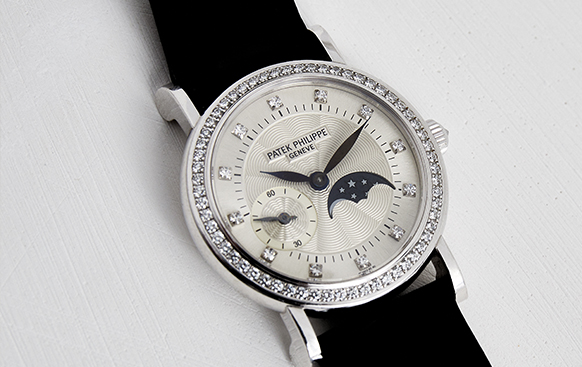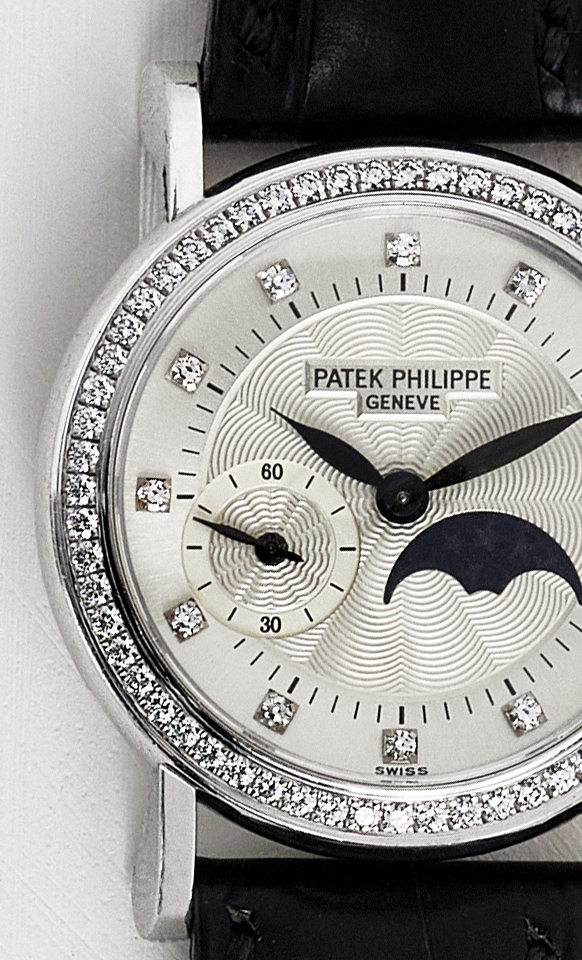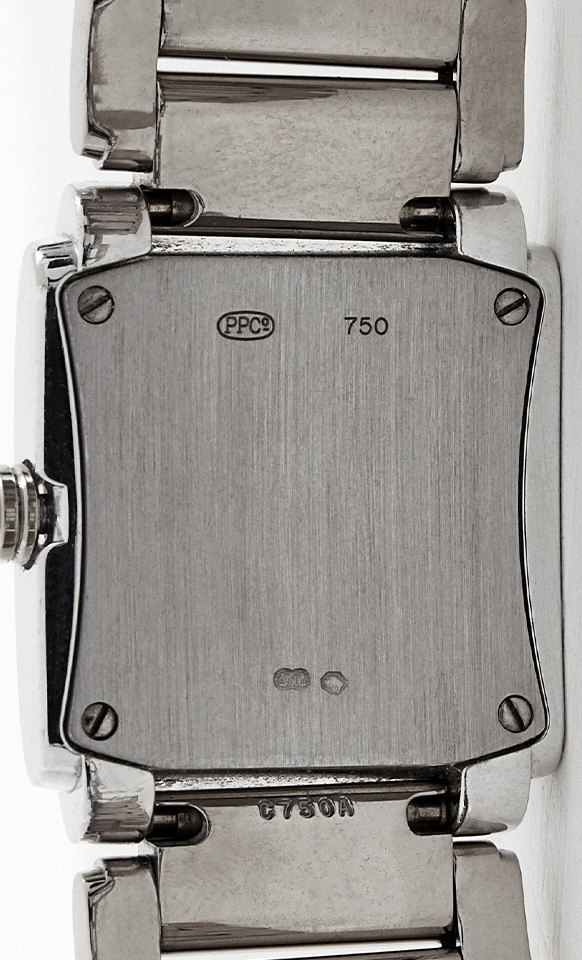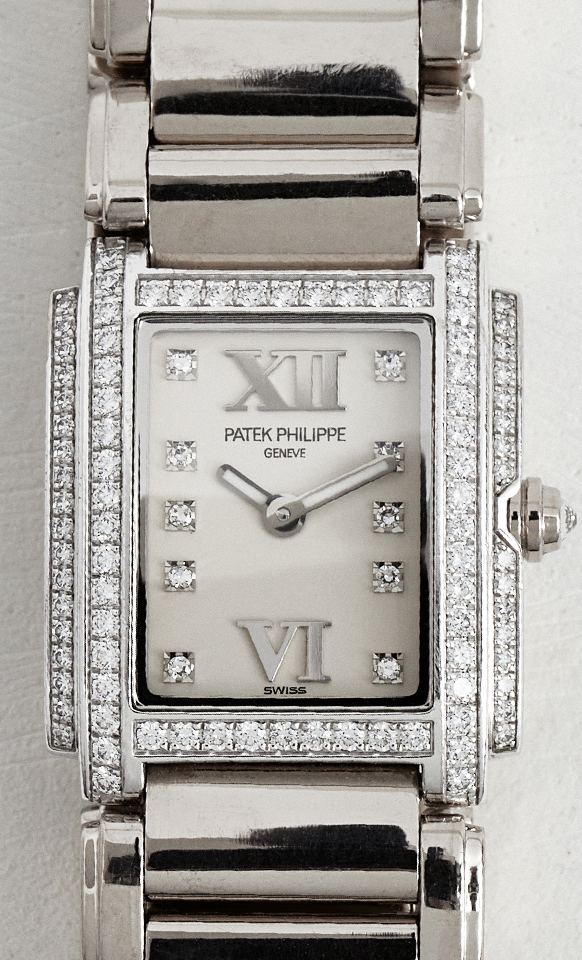

How to Spot a Real Patek Philippe Watch
Over fifty years before brands like Rolex were even conceived, Patek Philippe was breaking records. The watch manufacturer was founded in 1839 in Geneva, Switzerland, where Patek Philippe has made its watches since the very beginning. Patek Philippe was patenting its technological feats as early as 1845 for keyless winding, perpetual calendar mechanisms and double chronographs in pocket watches. To this day, Patek Philippe is synonymous with innovation, precision, quality timekeeping and craftsmanship.
Like with any luxury item, there’s the ultimate inevitably of counterfeits. So when a watch hits the desk of an expert at The RealReal, they examine it from clasp to lugs. In short: they know if it’s the real deal.
“When checking a Patek Philippe watch for authenticity, we always start by using a loupe, a small magnifying glass,” says Senior Watch Valuation Manager at TRR, Kamilla Akbarova. “Then we work closely with our watchmakers, who use tweezers and screwdrivers to inspect the internal parts. The more expensive the watch, the more likely it is to be counterfeited. The Nautilus and Calatrava models, as well as those with complications, are heavily replicated.”
A high degree of care, expertise and skill goes into each and every finished Patek Philippe creation, and divining the authenticity of one of the brand’s watches is an art and a science in its own right. Here, Akbarova demystifies these iconic timepieces and shows us how to check if your Patek Philippe is real.
How to Check If Your Patek Philippe Is Real
Patek Philippe Craftsmanship
While many Swiss brands “blue” their screws, a process that makes them more resistant to corrosion, Patek Philippe does not. Authentic Patek watches like this Calatrava should never include blue screws.
What distinguishes a Calatrava or a Nautilus from other luxury watches, and why are Patek Philippe watches so expensive? In a word: craftsmanship. The cost reflects the unbelievable precision with which Patek Philippe crafts their timepieces. After machining, each part of a Patek Philippe watch goes through hand-finishing and decorating. Watchmakers check cases and bracelets for their functionality so that they can seamlessly house delicate parts and movements, and these artisans use secret, age-old techniques to create the dial. The company puts emphasis on quality over quantity, hence the limited availability of their sought-after models. Every inch of a Patek Philippe watch should feature meticulous finishing.
Patek Philippe watches have particular proportions that are dictated by the chosen movement, case size and featured complications. Often, counterfeiters will be unable to replicate the exact shape of a Patek Philippe watch case. When checking to see if your Patek Philippe watch is real, make sure the crown and any pushers are functional. Faux versions with chronograph movements often feature non-functional pushers.
Some Patek Philippe models have distinguishing characteristics to help you tell real from faux. Platinum Patek Philippe watches, for example, should carry a distinctive single diamond setting between the lugs at 6 o’clock, while watches featuring a Tourbillon complication should only expose this complication on skeletonized versions.
In contrast to many other high-end Swiss watches, Patek Philippe does not “blue” their screws. This is a process of heating the screws in order to harden them and make them more resistant to corrosion; screws appear visibly blue. Many counterfeit watches will use this technique in order to make the inauthentic watch appear higher quality.
Patek Philippe Details

If a Patek Philippe includes a moonphase complication, as seen on this Calatrava, the stars and moon should have clean, crisp edges.
The dial is the focal point of a Patek Philippe watch, and can reveal much about the authenticity of your timepiece. There is a certain crispness and purpose to a Patek Philippe watch dial. Each one takes about four to six months of production, totaling between 50 to 200 separate operations, and after each step the dial is cleaned in an ultrasound bath. Most counterfeit Patek Philippe watches do not take proportions or aesthetic balance into consideration, and very often a fake Patek Philippe will feature exaggerated print to fill the negative space on the dial.

The guilloché pattern on an authentic Patek Philippe watch, like this Calatrava, should feature well-defined grooves.
Markers on authentic Patek Philippe watches should be evenly spaced, no matter the model. All modern-day Patek Philippe watches will use sapphire crystals, and the textured pattern often found on Patek Philippe dials is known as a guilloché dial. Guilloché dials on Patek Philippe watches should never be stamped, and they are not engraved by an automatic machine. Each line and groove is meticulously carved by a Patek Philippe guillochéur using a lathe to produce a beautiful visual effect. These grooves should be immaculate and well defined.
Patek Philippe watches with moonphase complications will feature a patterned wafer that rotates on an aperture. The stars and moon on the complication seen above have been applied through a vacuum process through a photographic mask. This process creates crisp perfect images on the dial. Any Patek Philippe moonphase complication should have stars and a moon with clean edges. This is a detail counterfeiters often overlook.
Patek Philippe Hallmarks

A number of hallmarks should be present on authentic Patek Philippe watches denoting metal purity, standards of quality and the source of the manufacturer. This Twenty~4 model features four hallmarks.
Authentic Patek Philippe watches should include a number of hallmarks and serial numbers that will help you spot the real deal. Reference and serial numbers should not be visible on a Patek Philippe watch’s caseback, and faux versions will often have model or serial numbers visible on the caseback. Exhibition casebacks, however, are another story. Serial and calibre numbers may be visible on timepieces with exhibition casebacks.
Patek Philippe watches should also include multiple metal purity hallmarks on their casebacks. Original stamping is difficult to recreate, especially as pieces worn throughout decades may show signs of wear. Crisp hallmarks on older timepieces can actually be a red flag.
In the image above, two markings are seen at the top of the caseback — the first is a “responsibility hallmark,” required by Swiss law, that identifies the source of the manufacturer. Depending on the age of the timepiece and the type of movement, the case should be stamped with either the Geneva seal or Patek Philippe seal. A double P signifies that the latter is displayed here.
Most of Patek Philippe’s unique elements of quality are requirements of the Geneva Seal Bureau, an independent organization that grades watches based on a set of 12 criteria centered around materials and finishing. However, Patek Philippe ended their 120-year affiliation with the Geneva Seal quality mark in 2009 by developing their own seal. Since then, Patek no longer sends their watches for inspection to the Geneva Seal Bureau and instead affixes their own Patek Philippe seal to testify they have met the most exclusive and stringent standards of quality.
The 750 to the right of the responsibility hallmark is a “standard of metal fineness,” revealing that this watch is made of 18-karat white gold. At the bottom of the caseback are two other hallmarks. The left is a “common hallmark,” depicting an engraving of a scale. This denotes a degree of metal purity that is internally accepted for Patek Philippe. Beside the scale is the official Swiss hallmark—a tiny dog head. Note that on some watches, only a few of these hallmarks may actually be present and visible on the caseback.
Select Calatrava models will also include a Greek cross with fleur-de-lis at its ends on the crown, caseback and/or clasp. If these hallmarks are present, they should be well-executed and proportionate. Counterfeits will often create large engravings that are disproportionate to the size of the watch.
Patek Philippe Diamonds

Diamonds on a Patek Philippe watch like this Twenty~4 model should be consistent, with internally flawless clarity. Any visible differences between diamonds can be a sign of inauthenticity.
Close examination of the diamonds on a Patek Philippe should yield only the highest quality stones. Patek Philippe hand-selects each diamond to ensure matching consistency. All diamonds on a Patek Philippe are D to G color, with internally flawless clarity. Any visible differences in diamond quality can be a sign of inauthenticity.
The Patek Philippe Twenty~4 pictured above, reference 4908, features diamond markers and a diamond bezel. Every hour marker will have been faceted or polished prior to being affixed to the dial itself, and the finished product should reflect this precision. These markers should be set on appliqués, slightly elevating them and creating contrast on the dial. On counterfeit Twenty~4 models, we often see stones that are cubic zirconia instead of actual diamonds.
Shop our selection of Patek Philippe watches now.
All items are pre-owned and consigned to The RealReal. Trademarks are owned by their respective brand owners. No brand owner endorses or sponsors this ad or has any association and/or affiliation with The RealReal.
Please note: Brand standards, logos and other identifying features may have changed since the time of publication.





